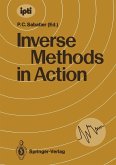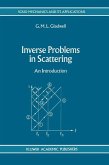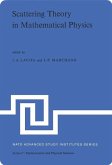

Alle Infos zum eBook verschenken

- Format: PDF
- Merkliste
- Auf die Merkliste
- Bewerten Bewerten
- Teilen
- Produkt teilen
- Produkterinnerung
- Produkterinnerung

Hier können Sie sich einloggen

Bitte loggen Sie sich zunächst in Ihr Kundenkonto ein oder registrieren Sie sich bei bücher.de, um das eBook-Abo tolino select nutzen zu können.
The normal business of physicists may be schematically thought of as predic ting the motions of particles on the basis of known forces, or the propagation of radiation on the basis of a known constitution of matter. The inverse problem is to conclude what the forces or constitutions are on the basis of the observed motion. A large part of our sensory contact with the world around us depends on an intuitive solution of such an inverse problem: We infer the shape, size, and surface texture of external objects from their scattering and absorption of light as detected by our eyes. When we use…mehr
- Geräte: PC
- ohne Kopierschutz
- eBook Hilfe
- Größe: 47.03MB
![Inverse Methods in Action (eBook, PDF) Inverse Methods in Action (eBook, PDF)]() Inverse Methods in Action (eBook, PDF)73,95 €
Inverse Methods in Action (eBook, PDF)73,95 €![Inverse Problems in Scattering (eBook, PDF) Inverse Problems in Scattering (eBook, PDF)]() G. M. L. GladwellInverse Problems in Scattering (eBook, PDF)113,95 €
G. M. L. GladwellInverse Problems in Scattering (eBook, PDF)113,95 €![Scattering Theory in Mathematical Physics (eBook, PDF) Scattering Theory in Mathematical Physics (eBook, PDF)]() Scattering Theory in Mathematical Physics (eBook, PDF)40,95 €
Scattering Theory in Mathematical Physics (eBook, PDF)40,95 €![Mathematical Physics of Quantum Mechanics (eBook, PDF) Mathematical Physics of Quantum Mechanics (eBook, PDF)]() Mathematical Physics of Quantum Mechanics (eBook, PDF)40,95 €
Mathematical Physics of Quantum Mechanics (eBook, PDF)40,95 €![Scattering Theory for Many-Body Quantum Mechanical Systems (eBook, PDF) Scattering Theory for Many-Body Quantum Mechanical Systems (eBook, PDF)]() I. M. SigalScattering Theory for Many-Body Quantum Mechanical Systems (eBook, PDF)19,95 €
I. M. SigalScattering Theory for Many-Body Quantum Mechanical Systems (eBook, PDF)19,95 €![Schrödinger Operators, Aarhus 1985 (eBook, PDF) Schrödinger Operators, Aarhus 1985 (eBook, PDF)]() Schrödinger Operators, Aarhus 1985 (eBook, PDF)28,95 €
Schrödinger Operators, Aarhus 1985 (eBook, PDF)28,95 €![Solitons (eBook, PDF) Solitons (eBook, PDF)]() G. EilenbergerSolitons (eBook, PDF)73,95 €
G. EilenbergerSolitons (eBook, PDF)73,95 €-
-
-
Dieser Download kann aus rechtlichen Gründen nur mit Rechnungsadresse in A, B, BG, CY, CZ, D, DK, EW, E, FIN, F, GR, HR, H, IRL, I, LT, L, LR, M, NL, PL, P, R, S, SLO, SK ausgeliefert werden.
- Produktdetails
- Verlag: Springer Berlin Heidelberg
- Seitenzahl: 499
- Erscheinungstermin: 6. Dezember 2012
- Englisch
- ISBN-13: 9783642833175
- Artikelnr.: 53381402
- Verlag: Springer Berlin Heidelberg
- Seitenzahl: 499
- Erscheinungstermin: 6. Dezember 2012
- Englisch
- ISBN-13: 9783642833175
- Artikelnr.: 53381402







